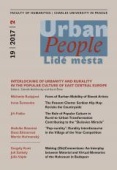Faces of Rurban Mobility of Slovak Artists (preliminary study)
DOI:
https://doi.org/10.14712/12128112.3319Klíčová slova:
Central Europe, rurbanization, visual artsAbstrakt
This paper focuses on the phenomenon of the mobility of artists from the city to the countryside in the context of rurbanization. It examines contemporary forms of artistic mobility that tend to be a new source of inspiration for artists, but at the same time also a stimulus for the general processes of rurbanization. The paper presents a preliminary investigation in terms of three case studies. The first one concerns Fero Guldan, a freelance visual artist, writer, sculptor, and painter; the second one focuses on Andrej Dúbravský, currently one of the most outstanding young Slovak visual artists; and the third case study deals with the Zaježová community, located in a widely spread-out village that attracts different forms of artistic activities. Research relied on the snowball method to extensively map the mobility of Slovak artists. The paper brings up such questions as what were the artists’ motives for leaving the city and moving to the countryside; if and how mobility affected their manner of artistic creation, the nature of their works of art (types of artefacts, topics, or colours), and the ways in which these works of art are distributed (for example, changing concepts of exhibitions) and received (types and attitudes of audiences); and what are the forms of artist associations (groups, communities). Even if all three of the cases have their own particularities, we can see that all but one of these attributes are changing. Painting techniques, topics, and colours have changed, as have the concepts of exhibiting art, but forms of association do not seem to be affected much by moving to the countryside. Furthermore, the Zaježová community has broken the binary opposition of urban vs. rural by creating a form of life and associations that go beyond the pub/café split.
Stahování
Publikováno
Jak citovat
Číslo
Sekce
Licence

Tato práce je licencována pod Mezinárodní licencí Creative Commons Attribution-NonCommercial-NoDerivatives 4.0.


